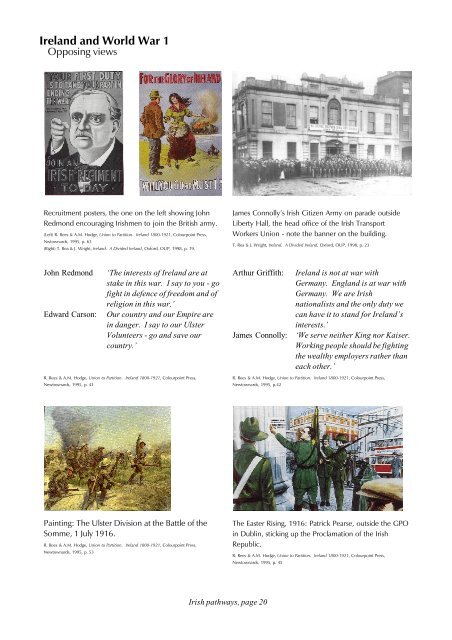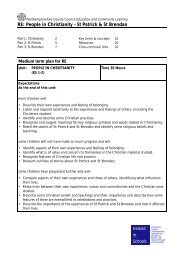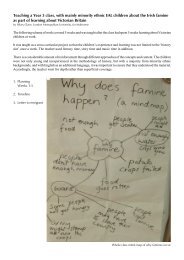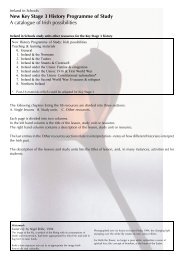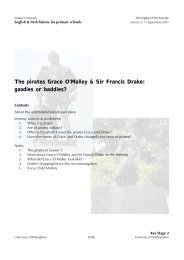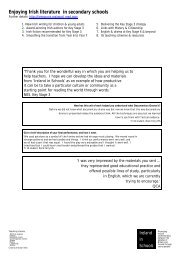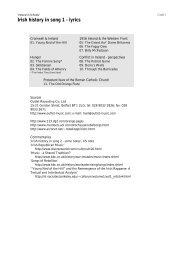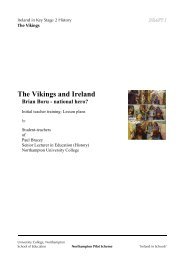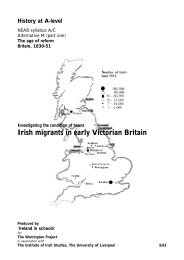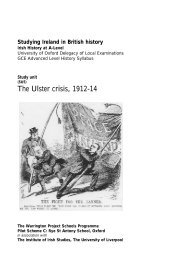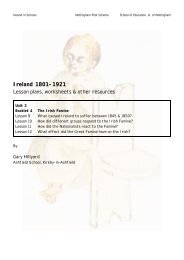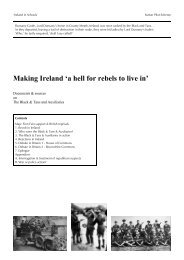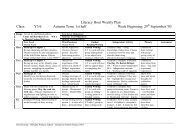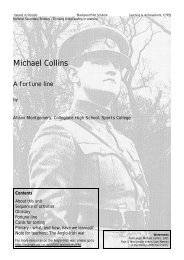Ireland & World War I
Ireland & World War I
Ireland & World War I
- No tags were found...
You also want an ePaper? Increase the reach of your titles
YUMPU automatically turns print PDFs into web optimized ePapers that Google loves.
<strong>Ireland</strong> and <strong>World</strong> <strong>War</strong> 1Opposing viewsRecruitment posters, the one on the left showing JohnRedmond encouraging Irishmen to join the British army.(Left) R. Rees & A.M. Hodge, Union to Partition. <strong>Ireland</strong> 1800-1921, Colourpoint Press,Nwtownards, 1995, p. 63(Right) T. Rea & J. Wright, <strong>Ireland</strong>. A Divided <strong>Ireland</strong>, Oxford, OUP, 1998, p. 19.James Connolly’s Irish Citizen Army on parade outsideLiberty Hall, the head office of the Irish TransportWorkers Union - note the banner on the building.T. Rea & J. Wright, <strong>Ireland</strong>. A Divided <strong>Ireland</strong>, Oxford, OUP, 1998, p. 23John RedmondEdward Carson:‘The interests of <strong>Ireland</strong> are atstake in this war. I say to you - gofight in defence of freedom and ofreligion in this war.’Our country and our Empire arein danger. I say to our UlsterVolunteers - go and save ourcountry.’R. Rees & A.M. Hodge, Union to Partition. <strong>Ireland</strong> 1800-1921, Colourpoint Press,Newtownards, 1995, p. 41Arthur Griffith:James Connolly:<strong>Ireland</strong> is not at war withGermany. England is at war withGermany. We are Irishnationalists and the only duty wecan have it to stand for <strong>Ireland</strong>’sinterests.’‘We serve neither King nor Kaiser.Working people should be fightingthe wealthy employers rather thaneach other.’R. Rees & A.M. Hodge, Union to Partition. <strong>Ireland</strong> 1800-1921, Colourpoint Press,Newtownards, 1995, p.42Painting: The Ulster Division at the Battle of theSomme, 1 July 1916.R. Rees & A.M. Hodge, Union to Partition. <strong>Ireland</strong> 1800-1921, Colourpoint Press,Newtownards, 1995, p. 53The Easter Rising, 1916: Patrick Pearse, outside the GPOin Dublin, sticking up the Proclamation of the IrishRepublic.R. Rees & A.M. Hodge, Union to Partition. <strong>Ireland</strong> 1800-1921, Colourpoint Press,Newtownards, 1995, p. 45Irish pathways, page 20
<strong>Ireland</strong> and <strong>World</strong> <strong>War</strong> 1The Easter Rising, 1916, and conscription, 1918An artist’s impression of the sceneinside the General Post Office,Dublin, at the height of the EasterRising, just before the surrender.Patrick Pearse stands (hatless andholding a revolver) on the left of thestretcher, where James Connolly lieswounded.The artist has caught the ‘romance’ ofthe occasion in heroic style.Compare this visual impression withSean O’Casey’s description below.In the sky the flames weresoaring higher, till the heavenlooked like a great rubyhanging from God’s ear. Nowit was above them [Volunteers]locking away the roof fromover their heads, and they weretoo weary to go on trying to putit out. Their faces werechipped into bleedingjaggedness by splinters flyingfrom shattered stones and brick... their leaders, before a wallof flame, standing dignifiedamong them, alreadygarlanded for death. They hadhelped God to rouse up<strong>Ireland</strong>.Sean O’Casey never took part in theEaster Rising. He reckoned that theleaders of the Irish Volunteers had notthe interests of the workers at heart.He bitterly resented Connolly bringingout the Citizen Army in what O’Caseyregarded as an irrelevant revolt.During the Rising he roamed thestreets and left this vivid writer’saccount of the destruction of theGPO.Michael Hodges, <strong>Ireland</strong>. From Easter Uprising to Civil <strong>War</strong>,Batsford, London, 1987, p. pp 23, 47.O’Casey’s reservations about theRising were also powerfullyexpressed in his play The Ploughand the Stars. The audience jeeredand rioted when it was firstproduced in Dublin in 1926,angered by the appearance of theCitizen Army flag alongside aprostitute in a pub, and byO’Casey’s refusal to mythologise therebel leaders.Reproduced in T. Rea & J. Wright, <strong>Ireland</strong>. A Divided<strong>Ireland</strong>, Oxford, OUP, 1998, p. 32.Sinn Fein anti-conscription propaganda, 1918.The poster on the right parodies an earlierrecruiting poster. The postcard on the left is called‘The first Irish conscript’.(Left) V.Kelly et al., Divided Island, Colourpoint Press, Newtownards, 1996 p. 54.(Right) R. Rees & A.M. Hodge, Union to Partition. <strong>Ireland</strong> 1800-1921, Colourpoint Press, Newtownards, 1995, p. 72.Irish pathways, page 21
<strong>Ireland</strong> and <strong>World</strong> <strong>War</strong> 1Opposing views - questions1. Look at the recruitment posters.What emotions and feelings are they appealing to? 32 Look at the language used by John Redmond, Edward Carson, Arthur Griffith and JamesConnolly.(a) What words or phrases are used to gain support for the war? Explain their importance.4(b) What words or phrases are used to oppose the war? Explain their importance. 43. Look at the paintings of the Battle of the Somme and Patrick Pearse.Explain the different actions of the Ulster Unionists and Irish Republicans in 1916. 44. Compare the artist’s impression with Sean O’Casey’s account of the scene inside the GPO inDublin.In what ways are they similar and different? 45. Compare the anti-conscription posters with the recruitment posters.Explain how and why they are so different. 625Irish pathways, page 22


